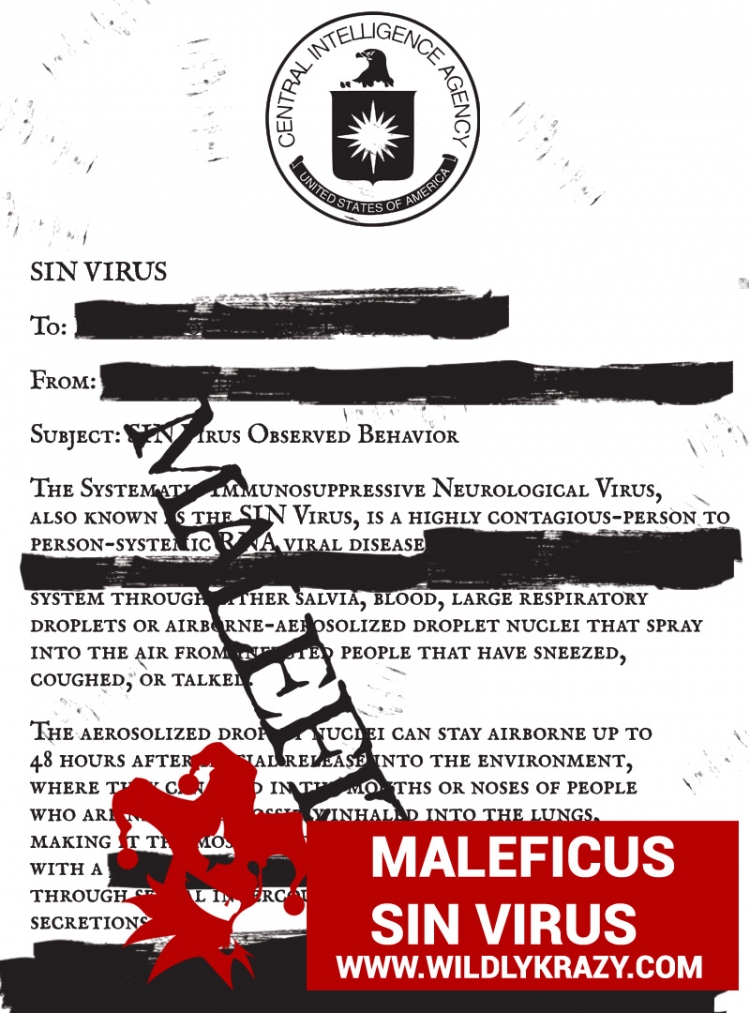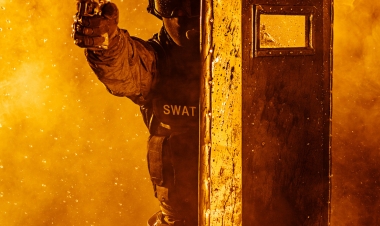MALEFICUS: SIN VIRUS
June 1, 2018 [WILDLY KRAZY]—MALEFICUS; coming summer 2018
To: Director of Central Intelligence
From: Deputy Director, Officer of Scientific Intelligence
Subject: SIN Virus Observed Behavior
The Systematic Immunosuppressive Neurological Virus, also known as the SIN Virus, is a highly contagious-person to person-systemic RNA viral disease that attacks both the immune and central nervous system via the respiratory system through either saliva, blood, large respiratory droplets or airborne-aerosolized droplet nuclei that spray into the air from infected people that have sneezed, coughed, or talked.
The aerosolized droplet nuclei can stay airborne up to 48 hours after initial release into the environment, where they can land in the mouths or noses of people who are nearby or possibly inhaled into the lungs, making it the most contagious virus known, with a 96% infection rate. The SIN Virus also spreads through sexual intercourse, via sperm, blood, or vaginal secretions.
As of yet, there is no known cure for the SIN Virus, due to the fact that it is a hardy virus that can stay airborne for up to 48 hours, and can live on almost any environmental surface for up to a month or two months, depending on many factors. In addition, the SIN Virus spreads quickly and easily, and it mutates just as fast, allowing the virus to easily infect and spread. Moreover, a person can carry and transmit the SIN Virus for many weeks before any symptoms show themselves, while also contagious for many months or more before any visible signs of disease become apparent. Within three days after infection of the respiratory system, the infected person can infect dozens of people without any significant symptoms or signs of illness for weeks to months on end, which, in return, infecting dozens more, and so on, allowing the SIN Virus to spread and infect very silently and quickly to countless amount of hosts, undetected.
The SIN Virus seems "extraterrestrial" in nature and "intelligently designed"—designed to kill, and cause species extinction. The virus seems "too perfect" and "well-designed" to originate from nature.
After approximately a day of replication in the respiratory system, which is the portal of entry and the site of shedding, the SIN virus immediately begins attacking the immune system, weakening it against an onslaught of the acute SIN Virus infection, infecting and spreading very quickly throughout the body through intracellular and extracellular routes.
The SIN Virus attacks the immune system through the local lymphatic, spreading to the lymph nodes, where the virus multiplies and spreads to other lymph nodes, entering the blood and peripheral nerves, migrating towards the central nervous system and to the rest of the body. The SIN Virus then begins replicating in the immune and nervous system, eventually causing both local and disseminated disease, leading to skiaanthropos and agrionous diseases.
After symptoms finally appear, about a few weeks after infection of the respiratory system, the symptoms appear to be a common cold: sneezing, coughing and a sore throat, along with shaking-cold sweats and chills. By this point, the SIN virus has already started replicating in the immune and nervous system, causing viral encephalitis.
Approximately three days after symptoms appear, inflammation of the lungs begin, producing a lot of phlegm and mucus, causing the infected person to cough up dark yellow, greenish or rusty brown mucus, followed with shortness of breath, chest tightness and fever, and eventually severe pneumonia.
On the fourth or fifth day of symptoms, the infected person begins coughing up dark blood, vomiting and running a severe fever that leads to difficulty of breathing, dehydration, nystagmus, photophobia, dizziness and weakness, confusion and amnesia, delirium, body tremors, muscle pain and spasms. In most cases, urination and defecation of oneself, followed by seizures, unconsciousness, coma and then death.
When a person is infected with the acute SIN Virus, the virus attacks, depleting the body's immune cells—which defend against infection—but if a person's immune system can stand up to this initial attack—meaning their immune cells are not as depleted in the first stages of infection—then they are more likely to survive the acute disease.
Nevertheless, the acute SIN Virus has the highest kill rate—80% kill rate with the acute SIN Virus, killing almost everyone during the acute virus stage—among children, older people, and those with poor immune systems or immunodeficiency, while the younger and stronger have the greatest chance of surviving the acute SIN Virus. Moreover, the SIN Virus is both an acute and a chronic viral disease, meaning that the virus never leaves the body and the infected person, if survived the acute virus, will become a chronic carrier, also known as a Sinner. This means, that eventually, the SIN Virus will kill every infected person through either the acute stage, or the chronic stage. With the chronic virus, however, Sinners do not develop symptoms—besides the physical and neurological damage caused by skiaanthropos and agrionous diseases—even though they harbor the virus and can transmit it to other people.
Overall, the chronic virus progressively destroys the host's brain and nervous system until death, which ranges from nine to eleven years of life expectancy with infection of the chronic SIN Virus. Ironically, however, only about 20–25% of infected adults die from chronic SIN Virus-related diseases, such as skiaanthropos and agrionous diseases. Therefore, the leading causes of death among Sinners are common complications, such as bacterial infections, common cold and influenza, and even suicide and murder among other Sinners and uninfected humans.
After about three to six months of the chronic SIN Virus wreaking havoc on the immune and nervous system—causing severe skin, brain and neurological damage, due to the steadily progression of brain deterioration and immunosuppression—the Sinner develops skiaanthropos disease. Skiaanthropos disease derives its name from the Greek words σκιά [shadow], and άνθρωπος [man/human/mankind]—"shadow man's disease".
The symptoms of skiaanthropos disease are hyperhidrosis, due to heat intolerance, damaged hair follicles that develop into alopecia areata, which eventually leaves the Sinner hairless over the entire body. Chronic anterior uveitis develops, which causes photophobia of the eyes to get worse, resulting in excruciating pain and migraines from bright lights or sunlight, which progresses to severe vision loss and haemolacria with frequent bleeding of the eye from tear ducts, while nystagmus in the eyes get worse. Photodermatoses also develops, resulting in bloody sores all over the body within minutes of being out in the sunlight, causing scarring and forcing the Sinners to become reclusive during the daytime and only coming out during the night to find food and water.
Skiaanthropos disease causes Sinner's core body temperature to run higher than normal human body temperature, which can cause them to overheat, leading to heat exhaustion or heatstroke. This is why Sinners are usually naked, which helps them stay cool.
Within nine to eleven months, agrionous disease, resulting in severe neurological damage, develops. Agrionous disease derives its name from the Greek words άγριος [fierce/wild], and νούς [mind]—"fierce mind disease".
Once agrionous disease develops within the Sinner's brain, they become extremely aggressive, violent and hostile, due to the development of psychological and mental disorders, such as schizophrenia, psychosis and delirium. Agrionous disease is the progress of brain deterioration that begins with psychological and mental issues, and gradually progresses to stupor, motionless catatonia and then death.
The brain and nervous system are the body’s control center. They control the body’s movements, the senses, the thoughts, and memories. They also control the organs such as the heart and bowels. The human brain naturally and gradually shrinks and deteriorates with age, resulting in a natural loss and breakdown of nerves that can affect the senses and body functions, which is a normal part of aging, whereas agrionous disease rapidly progressions the deterioration of the brain and nervous system, resulting in severe and dramatic neurocognitive deficits.
Agrionous disease causes diminished attention span, reduced or lost reflexes, loss of sensation, deteriorating sleep quality, flagging memory, slowing of movement and coordination, memory loss, mutism, deficits in abstract thinking and creativity, along with increased difficulty learning new tasks and retaining new information. Sudden and sporadic myoclonic twitches are also a commonly observed occurrence in Sinners, ranging from jerks and twitches of the head, shoulders, legs, or arms and even to seizures, due to the progressive neurological damage. Speech also gradually worsens from alogia and neologisms into grunts, barks and howls.
Nonetheless, our paramilitary officers—who infiltrated Chinese military ranks to observe Sinners—believe that Sinners somehow understand the neologistic communication within in the group, due to the fact of well-coordinated attacks and strategy put into the planning of their hunting parties. The neurological damage also causes delusions and hallucinations, which progresses to extreme piercings, self-mutilation, and cutting, ranging from minor to severe scaring-body-modifications.
Our targeting analysts, embedded with our paramilitary officers, believe that this self-mutilation and extreme body modifications might also be some type of group membership or affiliation, rites of passage, blood or symbolic ritual only Sinners understand, since the cutting and piercings are precise and deliberately based on sex and social status. For instance, males file all of their teeth into sharp points, resembling some short of animalistic admiration, while only the fang teeth sharpened on the females, resembling feline fangs or a form of yaeba. In addition, only certain males within the group split their tongues into a snakelike appearance, creating a social class among the group's males—perhaps a warrior class. In an even smaller group among the males, large cuts sliced across their right eye create a large keloidal scare reaching from their hairline to the bottom of their nose, creating, perhaps, an alpha male or leadership class.
Piercings and scarification is prevalent in both sexes, though; however only the males cut their entire backs, legs, and arms in horizontal lines, forming thick-large keloidal scars that resemble some type of armor or alligator skin, whereas only the females pierce their nostrils. Body paint is another self-expression among Sinners. Males cover their bodies in black dyes and paints of various tribal designs over their entire bodies, while the females use red dyes and paints. These basic tribal designs appear to be a type of communication or social class or expression among the group[s], creating an image that separates males and females—like a form of mating calls or signals.
Hyperactivity occurs among Sinners during the night, displaying patterns of impulsive and sporadic actions to increased adrenaline rushes and movements. Mania, rage, and turbulent behavior are other characteristics among Sinners during the night, which occurs during their hunting, feasting, and sexual activities, to what our targeting analysts have called "Lustful Rage," and "Manic Hunger".
Meanwhile, hypoactivity among Sinners is prevalent during the day—under the shelter from the sunlight—almost like sedative or tranquilized behavior to what our targeting analysts have called "Oblivious Mind".
"Oblivious Mind" comes from the hypoactivity of the Sinner during the daytime, making them oblivious to anything or anyone around them. They go into a stupor state, or some type of hibernation that leaves them immobile and vulnerable. During their "Oblivious Mind" state, Sinners seek very dark houses or shelters, and then lay down into a fetal position, or entwined among a large group of Sinners, resembling a snake-breeding ball, and sometimes, with mice, rats, insects and bugs crawling and biting at them, creating zero response or stimuli. Nonetheless, zero sexual activity or social interaction takes place within the huddle of Sinners, which leads to the belief that Sinners enter into a deep-sedative sleep during the daytime.
"Oblivious Mind" also comes from the fact that Sinners appear to have zero fear, and appear to feel zero pain, due to neurological damage of the brain and nerves. They will keep charging until death, oblivious to failing organs and blood loss from wounds. This "Oblivious Mind" state also makes Sinners unable to feel exhausted or winded from vigorous and strenuous cardio or physical activity, making them appear super fast and super strong—much more than uninfected humans that quickly become exhausted from continuous activity. This perceived super-human trait is a phenomenon often jokingly called "Retard Strength" among Chinese soldiers.
"Lustful Rage" comes from the observed sexual orgies from groups of three to observed numbers of fifty or more, taking place together in some sort of blood lust or ritual. Algolagnia and sadomasochism are a frequent and often observed occurrence during their vehement, and most often, violent-sexual activities that have ranged from biting, clawing, and even cutting to draw blood during the sexual acts of blood consumption. These orgies can last for hours to even a whole night, with numerous sexual partners, either simultaneously or separately. Though Sinners have sex like any normal or uninfected person, there has yet been a confirmed case of female Sinners getting pregnant and giving birth.
"Manic Hunger" describes their feeding habits. Sinners are both opportunistic hunters and scavengers that will eat just about anything that contains fresh blood and meat, either animal or human. Uncontrollable thirst for blood and meat, hallucinations, and paranoia, will often lead them to cannibalism, either among Sinners or among uninfected people; however, their thirst for uninfected people seems to be their preferred meal, keeping and forcing them into loose-makeshift alliances in order to give them better odds of securing uninfected meat and blood that they desire and crave.
During hunting, Sinners will use various types of weaponry, depending on what they can get their hands on, ranging from knives and swords to crude, crafty and creative homemade weaponry, and even rifles and handguns. However, a Sinner's accuracy and marksmanship with firearms is not very good due to their frequent, and sometimes, constant body twitching and jerks.
When they feast, they go into a manic-frenzy, devouring everything raw—except bone—and even fighting and killing other Sinners for their share of meat, which then adds more frenzy and fighting over the murdered Sinner[s].
Sinners will either chop off a hunk of meat and eat in seclusion or devour the food where it lays, forming "feeding packs" that resemble a pride of lions devouring a kill. However, it seems, just like in a pride of lions, alpha males and hunters feed first—often taking their share of the meat and eating in seclusion—while the lower class of Sinners fight over the scraps and remains among the feeding frenzy.
Useful tips for avoiding Sinners and infection of the SIN Virus:
—Come out during the day, and avoid unfamiliar houses and buildings for the risk of Sinners being inside or possible infection with the SIN Virus.
—Sinners are very contagious. Just entering the same house or building with a Sinner almost guarantees infection. Do not let a Sinner come close or breathe on you, and always wear your P3 Aegis Respirators [PAR3] when outside the safety of the security walls. Security and research personnel should always wear Positive Pressure Personnel Suits [PPPS] during the cleaning of weapons, machinery or during the research or handling of the SIN Virus or care and research of infected people. In addition, all work, security, and research personnel must enter mandatory decontamination rooms and showers before entering secured locations. This helps prevent contamination and infection among the populace, and military personnel.
—Though animals, such as dogs and cats, seem to be immune to the SIN Virus and cannot be a blood-carrier, you should never pet or hold stray animals, because of the possibility of the animal carrying the virus on its fur or paws, due to direct or indirect contact with Sinners.
—Barricade and shelter inside during the night, making sure your shelter is strong and secure, while staying as quiet as possible.
—Sinners will attack on sight without hesitation or any remorse.
—Sinners do not display any emotions or mercy, nor do they display any logical thinking as an uninfected person would, so you cannot reason with them. Sinners can never be your friend, child, spouse or family member, so avoid at all cost.
—Do not kiss or have sex with infected people.
—Due to their core temperature being higher, and due to their ease of heat exhaustion, Sinner's are more active during cooler and cold weather.
—Sinners come out during the night, often spewing saliva, blood, and vomit, contaminating the air and surfaces around them with aerosolized droplets. The SIN Virus can stay on almost any surface for months, while it can survive as droplets in the air up to 48 hours. Cold and low temperatures increase their survival while in the air and on environmental surfaces.
—Sinners do not feel pain, and they have zero fear due to their psychotic behavior, so they will not stop pursuit or attack until you or the Sinner are dead, which means wounding is out of the question. Shoot to kill during pursuit or attack by a Sinner, killing as fast as possible to keep a great distance between you and the Sinner, which diminishes your chances of infection from saliva, aerosolized droplets, or blood pathogens from the Sinner's bites or scratches.
—For an instant kill, aim either for the thoracic triangle on Sinner's chest or the T-line on the Sinner's head. The thoracic triangle is located between the nipples and the bottom of the neck where the heart, lungs, and other vital organs are located. The thoracic triangle region is the most advantageous area and easiest target for multiple hits for an immediate stop of a threat. Well-placed multiple shots from any caliber into the central upper thoracic triangle area is more likely to incapacitate the Sinner than elsewhere, besides the T-line on the head. All handguns are somewhat under-powered, so, unfortunately, it will usually take multiple well-placed shots into the upper thoracic triangle area in order to stop the Sinner quickly. Therefore, the ideal target-point is the T-line on the head, which is the area center of the face, between the upper lip and the bottom of the nose; however, the T-line is the hardest target to hit on the body, especially during high-stressful situations and movement, so this area is best for well-trained and experienced shooters.
Nonetheless, any high-velocity round will strike the medulla oblongata at the base of the brain, which controls all autonomic and involuntary muscle movement like heart beat and breathing, instantly killing without any involuntary muscle movement or twitching.
—Flash lights and bright lights will temporally blind a Sinner, throwing him into a violent fit of pain and agony, possibly giving you enough time to flee the area to safety. Flash bangs, spotlights and floodlights are good defensive and offensive weapons, along with UV lights, giving greater ability in controlling hordes and groups of Sinners.
An upcoming, original graphic novel by KRAZED—enjoy, Krazees!























Comments (0)